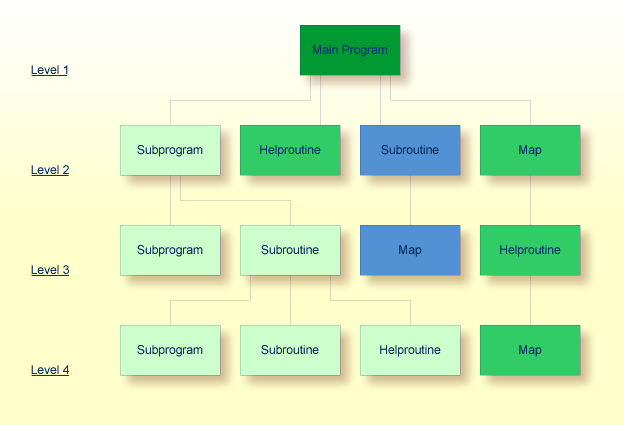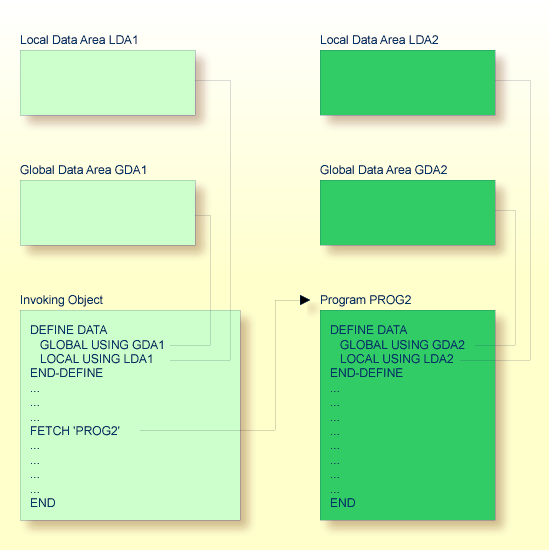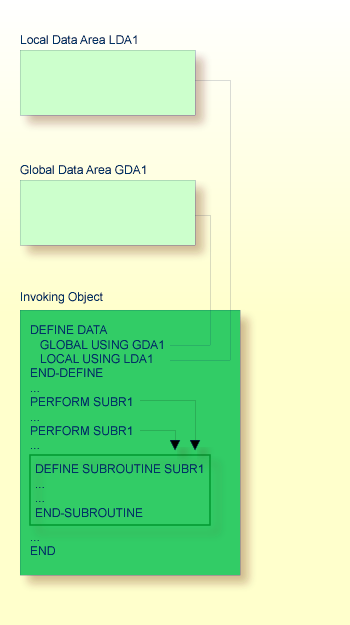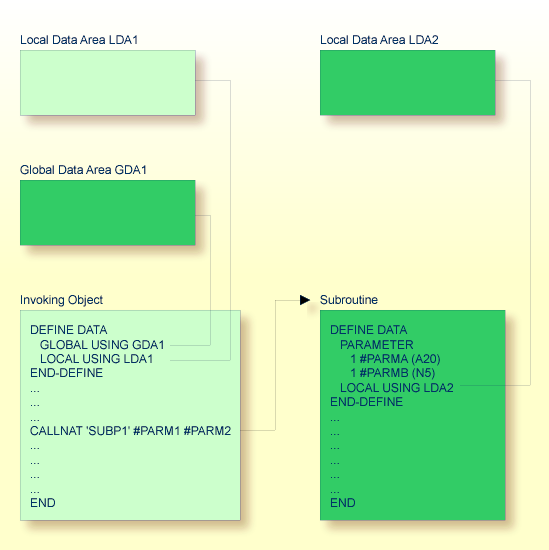This document discusses those object types which can be invoked as routines; that is, as subordinate programs.
Helproutines and maps, although they are also invoked from other objects, are strictly speaking not routines as such, and are therefore discussed in separate documents; see Helproutines and Maps.
This document covers the following topics:
Typically, a Natural application does not consist of a single huge program, but is split into several modules. Each of these modules will be a functional unit of manageable size, and each module is connected to the other modules of the application in a clearly defined way. This provides for a well structured application, which makes its development and subsequent maintenance a lot easier and faster.
During the execution of a main program, other programs, subprograms, subroutines, helproutines and maps can be invoked. These objects can in turn invoke other objects (for example, a subroutine can itself invoke another subroutine). Thus, the modular structure of an application can become quite complex and extend over several levels.
Each invoked object is one level below the level of the object from which it was invoked; that is, with each invocation of a subordinate object, the level number is incremented by 1.
Any program that is directly executed is at Level 1; any subprogram, subroutine, map or helproutine directly invoked by the main program is at Level 2; when such a subroutine in turn invokes another subroutine, the latter is at Level 3.
A program invoked with a FETCH statement from within
another object is classified as a main program, operating from Level 1. A
program that is invoked with FETCH RETURN, however, is classified
as a subordinate program and is assigned a level one below that of the invoking
object.
The following illustration is an example of multiple levels of invoked objects and also shows how these levels are counted:

If you wish to ascertain the level number of the object that is
currently being executed, you can use the system variable
*LEVEL
(which is described in the System Variables
documentation).
This document discusses the following Natural object types, which can be invoked as routines (that is, subordinate programs):
program
subroutine
subprogram
Helproutines and maps, although they are also invoked from other objects, are strictly speaking not routines as such, and are therefore discussed in separate documents; see Helproutines and Maps.
Basically, programs, subprograms and subroutines differ from one another in the way data can be passed between them and in their possibilities of sharing each other's data areas. Therefore the decision which object type to use for which purpose depends very much on the data structure of your application.
A program can be executed - and thus tested - by itself.
To compile and execute a source program, you use the system command
RUN.
To execute a program that already exists in compiled form, you use the
system command EXECUTE.
A program can also be invoked from another object with a
FETCH or
FETCH RETURN
statement. The invoking object can be another program, a
subprogram, subroutine or
helproutine.
When a program is invoked with FETCH RETURN, the
execution of the invoking object will be suspended - not terminated - and the
FETCHed program will be activated as a subordinate
program. When the execution of the FETCHed program is
terminated, the invoking object will be re-activated and its execution
continued with the statement following the FETCH RETURN
statement.
When a program is invoked with FETCH, the execution of
the invoking object will be terminated and the FETCHed program
will be activated as a main program. The invoking object will not be
re-activated upon termination of the FETCHed program.
The following topics are covered below:

A program invoked with FETCH RETURN can access
the global data area used by the invoking object.
In addition, every program can have its own local data area, in which the fields that are to be used only within the program are defined.
However, a program invoked with FETCH RETURN cannot have
its own global data area.

A program invoked with FETCH as a main program usually
establishes its own global data area (as shown in the illustration above).
However, it could also use the same global data area as established by the
invoking object.
Note:
A source program can also be invoked with a RUN
statement; see the RUN
statement in the Statements documentation.
The statements that make up a subroutine must be defined within a
DEFINE SUBROUTINE
... END-SUBROUTINE statement block.
A subroutine is invoked with a PERFORM statement.
A subroutine may be an inline subroutine or an external subroutine:
Inline Subroutine
An inline subroutine is defined within the object which contains the
PERFORM statement that invokes it.
External Subroutine
An external subroutine is defined in a separate object - of type
subroutine - outside the object which invokes it.
If you have a block of code which is to be executed several times within
an object, it is useful to use an inline subroutine. You then only have to code
this block once within a DEFINE SUBROUTINE statement block and
invoke it with several PERFORM statements.
The following topics are covered below:

An inline subroutine can be contained within a programming object of type program, subprogram, subroutine or helproutine.
If an inline subroutine is so large that it impairs the readability of the object in which it is contained, you may consider putting it into an external subroutine, so as to enhance the readability of your application.
An inline subroutine has access to the local data area and the global data area used by the object in which it is contained.

An external subroutine - that is, an object of type subroutine - cannot be executed by itself. It must be invoked from another object. The invoking object can be a program, subprogram, subroutine or helproutine.
An external subroutine can access the global data area used by the invoking object.
Moreover, parameters can be passed with the
PERFORM statement
from the invoking object to the external subroutine. These parameters must be
defined either in the DEFINE DATA
PARAMETER statement of the subroutine, or in a
parameter data area used by
the subroutine.
In addition, an external subroutine can have its local data area, in which the fields that are to be used only within the subroutine are defined.
However, an external subroutine cannot have its own global data area.
Typically, a subprogram would contain a generally available standard function that is used by various objects in an application.
A subprogram cannot be executed by itself. It must be invoked from another object. The invoking object can be a program, subprogram, subroutine or helproutine.
A subprogram is invoked with a CALLNAT statement.
When the CALLNAT statement is executed, the execution of
the invoking object will be suspended and the subprogram executed. After the
subprogram has been executed, the execution of the invoking object will be
continued with the statement following the CALLNAT statement.
With the CALLNAT statement, parameters
can be passed from the invoking object to the subprogram. These parameters are
the only data available to the subprogram from the invoking object. They must
be defined either in the DEFINE DATA
PARAMETER statement of the subprogram, or in a
parameter data area used by
the subprogram.

In addition, a subprogram can have its own local data area, in which the fields to be used within the subprogram are defined.
If a subprogram in turn invokes a subroutine or helproutine, it can also establish its own global data area to be shared with the subroutine/helproutine.
When the CALLNAT,
PERFORM or
FETCH RETURN
statement that invokes a routine - a subprogram, an external subroutine, or a
program respectively - is executed, the execution of the invoking object is
suspended and the execution of the routine begins.
The execution of the routine continues until either its
END statement is reached
or processing of the routine is stopped by an
ESCAPE
ROUTINE statement being executed.
In either case, processing of the invoking object will then continue
with the statement following the CALLNAT, PERFORM or
FETCH RETURN statement used to invoke the routine.
